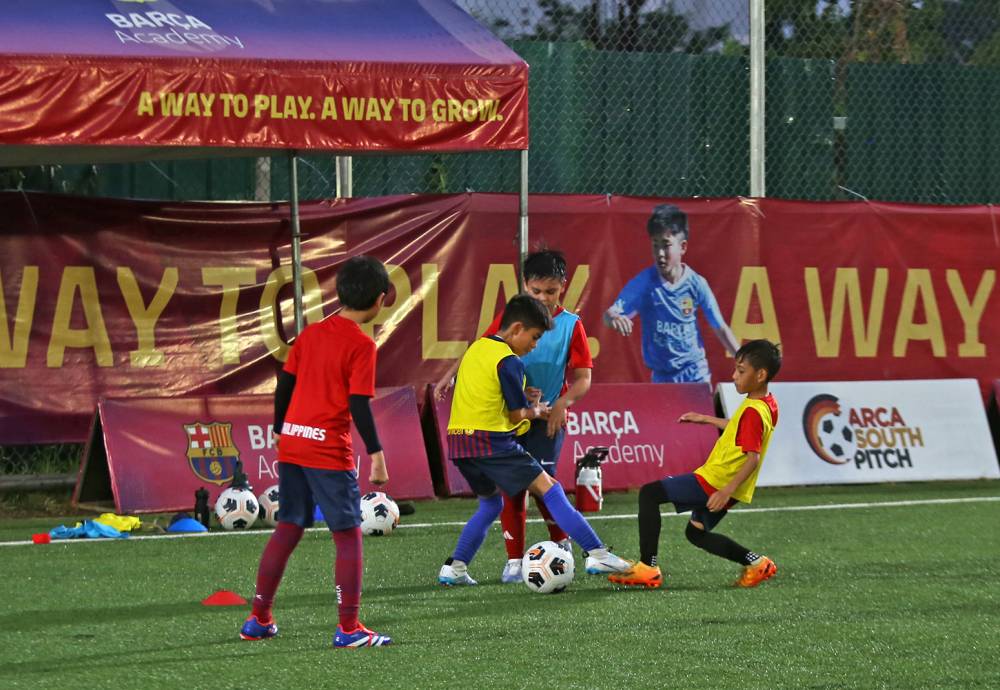Honing a Filipino Messi, the Barca way

“Go! Go back!” a coach goaded his student to chase after a ball gone astray.
Without any hesitation, the kid, possibly no older than 8, made a dash for it. Upon regaining possession, he took a deep breath and steadied himself. And with a dogged look on his face, he began to charge forward, trying his mighty best to dribble past his coach’s defense, and give himself a shot at the goal.
Elsewhere on the pitch, two groups of seven—one of students under 12, and another of under 10—were locked in their respective rounds of rondo drills.
But while these sessions could get pretty intense, there was always room for levity. Every so often, the metronomic thumps of balls being kicked and the mishmash of bellowed orders gave way to bursts of laughter and celebration.

The coaches cheered on, and, at times, playfully teased their wards to get them all pumped up. And for every job well done, high fives were dutifully exchanged.
For Joel Llinas, the technical director of Barca Academy Manila, there’s no better feeling than seeing students find joy in the sport.
“It’s the best feeling, seeing them enjoy themselves as they play football,” the Spanish player-turned-coach told Lifestyle in an interview at the Arca South’s FIFA-certified football pitch in Taguig City, home of the school’s regular football classes.

This is especially true for the 150 or so young enthusiasts, ages 6 to 16, that the school has welcomed since it opened last July. After all, talent and skill are honed through practice and repetition, which, in turn, are fueled by focus and sustained interest.
“If they don’t enjoy the sessions, they will get bored, and it will be difficult for them to improve. We don’t want to have these kinds of situations. So first, we make sure they enjoy what they do. The improvements will follow,” Llinas said.

Unique methodology
Luckily, excitement comes naturally with the school’s unique methodology.
The Barca Academy is the official school of FC Barcelona, the iconic Spanish club revered worldwide not only for its impressive list of achievements (three World Cup trophies among them), but also for its adroit and attractive style of play that centers around offense.
And the Manila school’s team of 12 Barca-trained coaches are well-equipped to teach and promote the storied club’s philosophy. “Some people say that we play differently, and I totally agree with that. We try to dominate the game. We always try to have the ball, and we always try to have the initiative. If you see us play, it’s easy to identify,” Llinas said.

Simply put, they make sure they’re the “main characters” on the field. They don’t dance to the music’s tempo; they dictate it. While it can be easier to tread safer routes, like playing long balls, they’re willing to take risks and be more creative with their plays. Yes, it’s challenging for the players, but ultimately more fun and thrilling to watch for spectators.
From Messi to Ronaldinho
“The Barca branding, of course, is famous around the world. And when people come here and try what we do in our training sessions, they end up wanting to keep on practicing because of the content we give them,” said Llinas, who regularly consults with the Barca headquarters in Spain to make sure the syllabus is always up to date and aligned with that of the 30 other academies across the globe.

This is the Barca way. And a lot of young Filipino hopefuls come in hoping to emulate legends like Lionel Messi, Gerard Pique, or Ronaldinho. Of course, there’s our very own Paulino Alcantara, the Iloilo-born striker who scored 395 goals from 1912 to 1927 for Barca. To this day, he holds the record as the youngest player to play or score for the club.
“Everyone has their own favorite players—this happens around the world. But it’s a good thing, because it only means they’re updated about Barca and its happenings,” Llinas said. “It’s always good to have someone to look up to.”

Arming students with sound fundamentals and technical proficiency is one thing; expecting them to flesh those out in a match setting is another. As such, the school gives its students opportunities to apply what they have learned through various friendly matches or tournaments, like the Azkals Tournament and Milo Cup.
The academy also fielded teams for the under-11 and under-13 categories of the Barca Asia-Pacific Cup in Nara, Japan, which featured teams from other Barca schools in the region. “We have been working really hard to give them these kinds of experiences … It’s important to give them a competitive context, so they can learn how to deal with pressure or frustration,” Llinas said.

The more matches the students play, the more they get acquainted with the intricacies and dynamics on the field, which they won’t get from routine drills or exercises.
“It’s also about understanding the space you’re in, where you have to be, what you need to do to take advantage of a situation. You have to be intelligent, too. That’s why we give them this context,” Llinas said.

And it’s for this very reason that Llinas believes aspiring football players must start training as early as possible.
“Of course, it doesn’t mean you can’t improve when you start later. It depends on the player. If you start playing at like 5, you will already have more experience by the time you’re 10. And experience makes you better,” he pointed out.

Holistic training
However, the equation to Barca’s holistic training approach wouldn’t be complete without character-building. Speed, ball-handling and strategic sense are crucial, but so are respect, effort, ambition, teamwork, and humility.
“It’s not only about what happens inside the field. It’s important for us to help them become better players and humans,” Llinas said. “That’s part of the path toward the goal of improving as individuals and as a team.”

The discipline is already apparent. Surely enough, after the students’ postsession huddle—where they sit down and reflect about the training they just had—they promptly cleared their stuff and picked up any wayward trash. And they made sure to shake hands with each one of their coaches and group mates before exiting the pitch.
In terms of popularity in the Philippines, it’s safe to say that football still lags behind well-loved and more readily accessible sports like basketball, volleyball and boxing. But interest has been steadily growing over the years, and the academy hopes to be a part of that journey.

“I think everyone’s trying their best to improve football here. We want to be part of that process. But it will take time. We have to be patient. Football isn’t the no. 1 thing in people’s minds at the moment. But I think we’re on the right path. We will see how we can help and grow the sport’s popularity,” Llinas said.
Worthy cause
Working with the academy is Ayala Land, which promised upgrades and facility for the pitch by 2025, including covered bleachers, locker rooms, common toilets and an administrative office.

“For now, our commitment is to provide this facility. But of course, if there’s a worthy cause and endeavor, and the academy needs our help—say, they have to go to international tournament—we will consider that,” Ayala Land marketing and communications group head Chrissy Roa told Lifestyle.
“Hopefully, we can find the next football stars here,” she added.
Are we getting too ahead of ourselves in thinking that the academy could produce a future FC Barcelona star?

“Who knows? The players here have the talent to play football and that’s important. But like I have said, it’s a long process. It’s not something that will happen in two years. We just have to keep practicing and improving,” Llinas said.
For now, he focuses on what’s in front of him. And what he sees couldn’t be more fulfilling.
“I see the players when they’re just starting with us. But after just a few months, they start to understand what we do. We see that they’re improving according to the way we want them to play,” Llinas said. “I think that’s my happiness.”





















